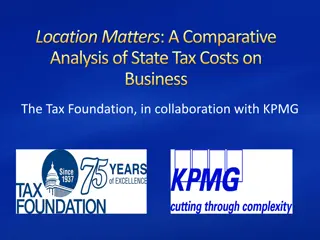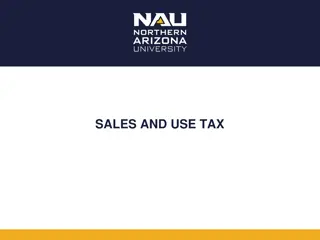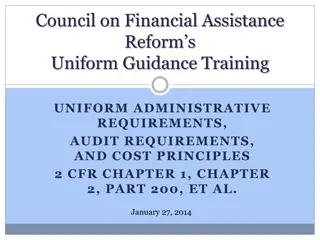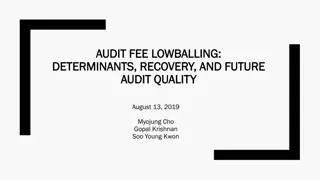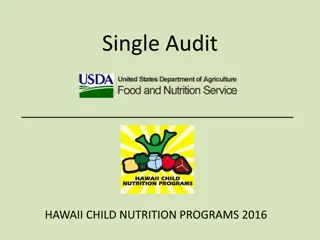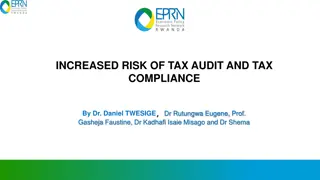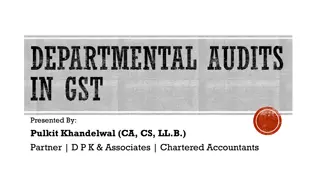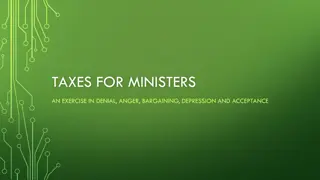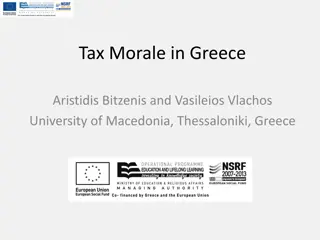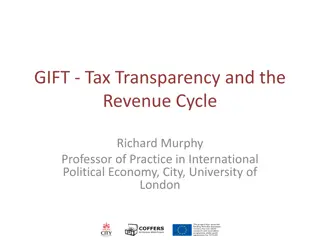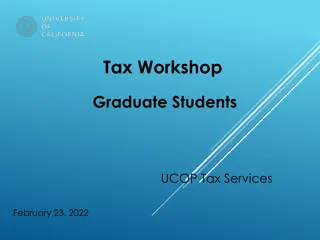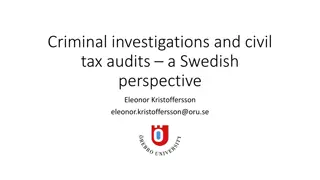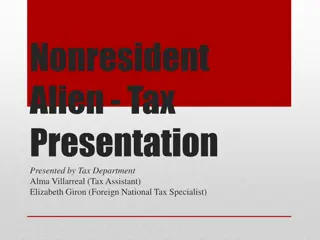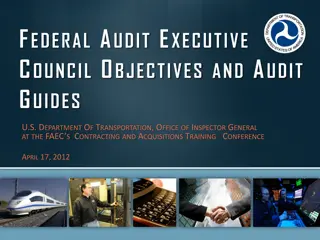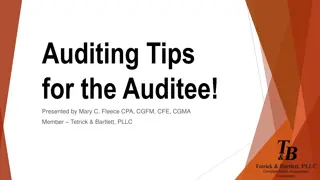Recent Issues in Tax Audit u/s 44AB
Recent issues in tax audit u/s 44AB, as presented by CA Nitin Daga from Gandhidham, cover various aspects such as applicability, interplay between sections 44AB and 44AD, turnover thresholds, and specific case studies. References used in the presentation include ICAI guidance notes and implementation guides. The content delves into eligibility criteria, exclusions, and calculation methods related to tax audits under section 44AB.
Download Presentation

Please find below an Image/Link to download the presentation.
The content on the website is provided AS IS for your information and personal use only. It may not be sold, licensed, or shared on other websites without obtaining consent from the author. Download presentation by click this link. If you encounter any issues during the download, it is possible that the publisher has removed the file from their server.
E N D
Presentation Transcript
Recent Issues in Tax Audit u/s 44AB CA NITIN DAGA , GANDHIDHAM +91 99250 26615
References used in this presentation ICAI Guidance Note on Tax audit u/s 44AB Revised 2014 edition Implementation guide wrt Notification dated 20/7/18 effective from 20/8/2018 Study on compliances in Reporting in Tax Audit Report issued by TAQRB ICAI (June 2022 edition) Exposure Draft Revised Guidance Note on Tax audit u/s 44AB
Applicability Profession referred in 44AA(1) : Gross receipts exceed Rs 50 Lacs in PY Profession u/s 44ADA ; Income < deemed profits 50% and TI >MANCT Note: Sec 44ADA is applicable only to individuals n partnership firms (other than LLP) Business u/s 44AE/44BB/44BBB ; Income < deemed profits Business u/s 44AD(4) & Profit < deemed profits and TI >MANCT Note: Sec 44AD is applicable only to individuals, HUF n partnership firms (other than LLP) If benefit of Sec 44AD(1) availed in any year , then in any of next 5 years if- (a) 44AD(1) not opted, then 44AD(1) ruled out for subsequent 5 years from the year of such option (b) In such a case, if TI >MANCT in any of the 5 years, tax audit is applicable.
Interplay between 44AB & 44AD 44AD Essentials Eligible assessee Individual , HUF & Firm (except LLP) & no deduction u/s 10A, 10AA, 10B, 10BA & Part C of Chapter VI A Eligible Business - Any business except 44AE and turnover < =Rs 2 crores Further Exclusions Profession referred in 44AA(1) /Commission / Agency business Deemed profits 8% or 6% Higher profits if not commensurate with funds flow Note: 44AD excludes the business of plying, hiring or leasing goods carriages (owned) referred to in section 44AE. Case study (a) What if assessee owns more than 10 vehicles but turnover is < 2 Cr (b) What if assessee is a GTA hiring vehicles owned by third parties and turnover is < 2 Cr (c) What if assessee owns less than 10 vehicles & is also third party vehicle GTA
Turnover threshold - 44AB(a) Normal Threshold 1 Crore Further Relaxation Aggregate of all amounts received in cash including for sales, turnover or gross receipts during the previous year does not exceed 5% of the said amount Aggregate of all payments made in cash including for expenditure during the previous year does not exceed 5% of the said amount HOW TO CALCULATE ABOVE F:\Data\ICAI\Tax Audit Applicability Check.xlsx
Exclusions from Turnover GST /VAT if credited to a separate account Discount allowed in sales invoice Turnover discount, even if allowed at periodic intervals thru credit notes Sales return Sale proceeds of fixed assets Sale proceeds of property held as investment Rental income unless assessed as business income Dividend / Interest except when it is assessable as business income Re-imbursement of expenses Write back of liabilities no longer reqd Interest / remuneration / share of profit recd by a partner from a firm (Perizad Zorabian Irani Vs PCIT Mumbai HC)
Inclusions in Turnover Cash assistance against exports under GOI scheme Duty drawback Interest recd by a money lender Forex fluctuation Insurance claims / LD claim Scrap sale Advance forfeited from customers Speculative transaction Aggregate of positive & negative difference Options Aggregate of premium received and paid Futures Aggregate of favourable & unfavourable difference on settlement (Not daily M2M) Delivery based transaction for share dealer Total value of sales
Inclusions in Turnover Cash assistance against exports under GOI scheme Duty drawback Interest recd by a money lender Forex fluctuation Insurance claims / LD claim Scrap sale Advance forfeited from customers Speculative transaction Aggregate of positive & negative difference Options Aggregate of premium received and paid Futures Aggregate of favourable & unfavourable difference on settlement (Not daily M2M) Delivery based transaction for share dealer Total value of sales
Due date & penalty Due date for filing report u/s 44AB for AY 2022-23 is 30/09/2022 Penalty 0.5% of turnover or Rs 1.50 lac whichever is less (271B) Is penalty automatic No penalty if assessee proves reasonable cause for such failure (273B) Some instances accepted by Courts as Reasonable Cause Resignation of tax auditor & consequent delay Bona fide interpretation of the term `turnover' based on expert advice; Death or physical inability of the partner in charge of the accounts Labour problems such as strike, lock out for a long period, etc. Loss of accounts because of fire, theft, etc. beyond the control of the assessee Non-availability of accounts on account of seizure Natural calamities, commotion, COVID
Restrictions on Auditors CA responsible for writing or maintenance of books of accounts cannot be tax auditor (Not even the firm in which such CA is a partner) Internal auditor can t be tax auditor Ceiling of 60 audits (Audit u/s 44AD & 44AE excluded)
Revised SA 700 F:\Data\ICAI\Guidance Note\tax audit\Guidance note_tax audit 44AB.pdf Para 11.10 Page 73 Having regard to the importance of these respective responsibility paragraphs from the perspective of the readers of the tax audit report, it is suggested that these respective responsibility paragraphs relating can be provided in the space provided for giving observations, etc., under clause (3) of Form No.3CA or Clause (5) of Form No.3CB as the case may be. Please don t refer to above para in notes attached (TAQRB) F:\Data\ICAI\Guidance Note\tax audit\Annexure_3CB.docx
Form 3CA Para 3 / 3CB Para 5 Assessee s Responsibility for Statement of Particulars in Form 3CD 1. The assessee is responsible for the preparation of the statement of particulars required to be furnished under section 44AB of the Income-tax Act, 1961 annexed herewith in Form No. 3CD read with Rule 6G(2) of Income Tax Rules, 1962 that give true and correct particulars as per the provisions of the Income-tax Act, 1961 read with Rules, Notifications, circulars etc that are to be included in the Statement. Tax Auditor s Responsibility 1. We are responsible for verifying the statement of particulars required to be furnished under section 44AB of the Income-tax Act, 1961 annexed herewith in Form No. 3CD read with Rule 6G (2) of Income-tax Rules, 1962. We have conducted my/our verification of the statement in accordance with Guidance Note on Tax Audit under section 44AB of the Income-tax Act, 1961, issued by the Institute of Chartered Accountants of India.
CLAUSE 8: INDICATE THE RELEVANT CLAUSE OF SECTION 44AB UNDER WHICH THE AUDIT HAS BEEN CONDUCTED 44AB(a) - Turnover from business > 1 crore 44AB(b) - Gross receipt from profession > 50 Lacs 44AB(c) Audit by virtue of provisions in sec 44AE / 44BB/ 44BBB 44AB(d) Audit by virtue of provisions in sec 44ADA 44AB(e) Audit by virtue of provisions in sec 44AD(4) Third proviso to Sec 44AB : Audited under any other law - Company / LLP with turnover >40 Lac / Co-op Society / Society The above assessees which are required to get their accounts audited under other statute, should not select option 44AB(a)
Clause 16 : Amount not credited to Profit & Loss Account being : (a) the items falling within the scope of section 28; (b) the proforma credits, drawbacks, refund of duty of customs or excise or service tax, or refund of sales tax or value added tax, where such credits, drawbacks or refunds are admitted as due by the authorities concerned; (c) escalation claims accepted during the previous year; (d) any other item of income; (e) capital receipt, if any. Requirement This clause requires auditor to report items listed in sub-clause (a) to (e) as mentioned below regarding the items not credited to profit & loss account . It could imply that reporting should be based on two distinct situations: Not credited the said items to profit & loss account and also omitted from books of account: o Under this situation auditor is required to obtain written representation w.r.t. all the items under this clause and also the reasons for not crediting the same. Crediting the said items in the books of account but not to the profit & loss account Clause a,d,e Under this clause various amounts falling within the scope of section 28 which are not credited to the profit and loss account are to be stated. However, those items which are reported in clauses 16(b), (c) and (d) need not be reported in clause 16 (a). Moreover items reported in clause (a) to (d) will be added in Clause 23 of Sch BP of ITR and in relevant column in OI schedule in ITR
Clause 16 (a): The items falling within the scope of section 28: It should be ensured that all the items falling within section 28 which have not been credited to the Profit & Loss Account are reported here. These are all incomes from business or profession. Clause 16 (b): Specific claims Under this clause, the details of the following claims, if admitted as due by the concerned authorities but not credited to the profit and loss account, are to be stated. a) Pro-forma credits b) Drawback c) Refund of duty of customs d) Refund of excise duty e) Refund of service tax f) Refund of sales tax or value added tax Clause 16 (c): Escalation claims accepted during the previous year Under this clause, the escalation claims accepted during the previous year but not credited to the profit and loss account should be stated. Escalation claims would normally arise pursuant to a contract (including contracts entered into in earlier years) a) if so permitted by the contract, and b) other party has signified unconditional acceptance could constitute accepted claims.
Clause 16 (d): Any other item of income Under this clause, various amounts falling within the scope of section 28 which are not credited to Profit & Loss account are to be stated Therefore any item of income which is not business income is not required to be reported. The tax auditor should report NIL in such cases. Illustrative examplles Interest , salary , dividend, rent , capital gain etc credited to capital account , not being income within scope of sec 28, is not required to be reported. Clause 16 (e): Capital receipt, if any The purpose of this clause is to inform the Tax Authorities about various capital receipts which have not been credited to profit & loss account so that they can determine whether such receipts are taxable or not and whether the assessee has offered such capital receipts for taxation, if taxable. Equity, loans and borrowings should not be stated under this sub-clause. Illustrative list of items to be included (a) Capital subsidy received in the form of Government grants which are in the nature of promoters contribution i.e., they are given with reference to the total investment of the undertaking or by way of contribution to its total capital outlay. For e.g. Capital Investment Subsidy Scheme. (b) Government grant in relation to a specific fixed asset where such grant is shown as a deduction from the gross value of the asset by the concern in arriving at its book value. (c) Compensation for surrendering certain rights. (d) Profit on sale of fixed assets/investments to the extent not credited to the profit and loss account.
CLAUSE 21(a): Expenditure by way of penalty or fine for violation of any law for the time being in force; Expenditure by way of penalty or fine not covered above; Expenditure incurred for any other purpose which is an offence or is prohibited by law: The courts have laid down that any penalty or fine for violation of law is not admissible as expenditure. It is in this context the requirement stipulated by clause 21(a) is to be answered. The auditor should examine the provisions of the relevant statute providing for payment of such impost notwithstanding the nomenclature of the impost as given by the statute, to find whether it is compensatory or penal in nature. Interest on late payment of GST / Service Tax is not required to be reported here. CIT Vs Bharat Steel Tubes Ltd (1997) 226 ITR 750 (Del) Late filing fee (TDS or GST) is not penalty, hence not required to be reported here. Rashmikant Kundalia Vs UOI (2015) 275 ITR 0138 (Bom)
Clause 21(g) - Particulars of any liability of a contingent nature The assessee is required to furnish particulars of any liability of a contingent nature debited to the profit and loss account. Contingent liabilities which are mentioned in notes to accounts are not to be reported here as they are not debited to profit and loss account. Reference may be made to AS-29, Provisions, Contingent Liabilities and Contingent Assets to determine what should normally be treated as a contingent liability.
Clause 23: Payments made to persons specified u/s 40A(2)(b) Persons specified in Section 40A(2)(b)- Page 290 F:\Data\ICAI\Guidance Note\tax audit\Guidance note_tax audit 44AB.pdf This clause deals with related party payments The Tax Auditor is not required to comment on the reasonableness or otherwise of such payments.
Clause 25: Deemed Profits / Gains u/s 41 Section 41(1): Reversal/writing back of trading liability o Under this section if any allowance or deduction that had been allowed to assessee in respect of any loss, expenditure or trading liability in any assessment year and in later years if assessee obtains such amount, then the same shall be chargeable to tax as business income. o If the assessee has written back some liability in the books of accounts and the expenditure represented by such liability had been allowed as deduction in any previous year, then such write back shall be taxable as business income. Liability of assessee does not cease merely because liability has become barred by limitation. Liability ceases when it has become barred by limitation and the assessee has unequivocally expressed its intention not to honour the liability, when demanded. When a liability is shown outstanding for more than 4 years, in case of an assessee company, this amounted to acknowledging the debt in favour of creditors for the purposes of section 18 of the Limitation Act, 1963. The amount was not assessable under section 41(1).This was so held by Delhi High Court in the case of CIT V/s Shri Vardhman Overseas Ltd(2012) 343 ITR 408(Del). SLP Dismissed in SC Section 41(4) Bad debts recovered It is to be noted that as per the Guidance Note, amount reportable under clause 41 is to be reported, irrespective of the fact whether the relevant amount has been credited to the profit and loss account or not. Clause 20 of Schedule BP in ITR Deemed income u/s 41
Clause 31(a) - Section 269SS Details to be reported under this sub-clause include: - whether the loan or deposit or specified sum was taken or accepted by cheque or bank draft or use of electronic clearing system through a bank account - in case the loan or deposit or specified sum was taken or accepted by cheque or bank draft, whether the same was taken or accepted by an account payee cheque or an account payee bank draft - Even squared off accounts to be included General disclaimer in Para 3 /Para 5 of 3CA/3CB It is not possible for us to verify whether loans or deposits or specified sum have been taken or accepted otherwise than by an account payee cheque or account payee bank draft, as the necessary evidence is not in the possession of the assessee .
Sale proceeds collected by the selling agent will not be considered as loan or deposit. Advance received against agreement of sale of goods is not a loan or deposit. Opening credit balance of loan taken in earlier years is not specifically required to be disclosed. However, while giving figures of maximum amount outstanding at any time during the year or while giving information about acceptance and repayment of loan/deposit, the opening balances in the loan accounts will have to be taken into consideration. Even if the loans are taken free of interest the information will still have to be given. Security deposits against contracts, etc. will be covered by the definition of deposit and therefore, such information will have to be given. Share application money received and remaining unallotted is not required to be reported here.
Section 269ST It provides that no person shall receive sum of Rs. 2 lakh or more a) in aggregate from a person in a day; or b) in respect of a single transaction; or c) in respect of transactions relating to one event or occasion from a person otherwise than by an account payee cheque or an account payee demand draft or by use of electronic clearing system through a bank account. Provisions of section 269ST do not apply to receipt by Government, any banking company, post office savings bank or a co-operative bank or transactions of loan or deposit or `specified sum referred to in section 269SS Section 269ST does not distinguish between receipt on capital account and revenue account If the amount of consideration for purchase is set off against the amount receivable for the sale of goods or services, such set off the is not a receipt as contemplated under section 269ST. While section 269ST deals only with receipts exceeding Rs. 2 lakh or more otherwise than by the specified modes, sub-clauses 31(ba), (bb), (bc) and (bd) require details to be furnished of both of receipts and payments. The CBDT, by a circular, has clarified that in respect of receipt in the nature of repayment of loan by NBFCs or HFCs, the receipt of one instalment of loan repayment in respect of a loan shall constitute a single transaction as specified in clause (b) of section 269ST of the Act and all the instalments paid for the loan shall not be aggregated for the purposes of determining applicability of the provisions of section 269ST
Clause 34(a) - Whether the assessee is required to deduct or collect tax as per the provisions of Chapter XVII-B or Chapter XVII-BB The auditor should obtain a copy of the TDS/TCS returns filed by the assessee which shall form the basis of reporting under this clause, to the extent possible. Specified rate means rate prescribed in the relevant section or the rate in force or lower rate on the basis of certificate issued u/s 195 or 197. Less than specified rate cases of short deduction to be reported here. In case an assessee has voluminous nature of the transactions, the auditor may apply test checks and compliance tests on the transactions reported in the TDS statements by the assessee for verifying the information required to be provided under this clause. It may be mentioned in Form 3CA / 3CB, as applicable: We have verified the compliance with the provisions of Chapter XVII-B / XVII-BB regarding deduction of tax at source / collection at source and regarding the payment thereof to the credit of the Central Government in accordance with the Auditing Standards generally accepted in India which includes test checks and the concept of materiality. Such audit procedures did not reveal any significant non-compliance with the provisions of Chapter XVII-B / XVII-BB.
Verification of compliance Section 206AA & 206AB Section 206AA is in statute book since FY 2010-11. Section 206AB is effective since 01/07/2021. The ICAI guidance note on tax audit u/s 44AB was last revised in 2014. The implementation guide wrt Notification No 33/2018 was made effective from 20/08/2018. Both the above publications do not contain any reference to Sec 206AA while reporting under clause 34(a). Therefore on this analogy, neither section 206AA nor section 206AB compliance is to be reported by us as tax auditors. The exposure draft on revised guidance note on tax audit u/s 44AB which is under discussion, also does not refer to section 206AB. Moreover the language deployed in clause 34(a) refers to specified rate . Specified rate means rate prescribed in the relevant section or the rate in force or lower rate on the basis of certificate issued u/s 195 or 197. Hence specified rate cannot be stretched to include higher rate as triggered in Section 206AA & 206AB.
TDS 194-Q Vs TCS 206C(1H) CBDT circular 13/2021 states that if a transaction is both within purview of section 194-Q as well as 206C(1H) , tax is required to be deducted u/s 194-Q only. If for any reason, TCS has been collected by seller before buyer could deduct tax u/s 194-Q, such transaction would not be subjected to tax again by the buyer. This concession is provided to remove difficulty. As regards question of disallowance of expenditure u/s 40a(ia) in such a case, it must be noted that - CBDT circular is binding on revenue authorities (Apex court ruling 267 ITR 0272) - Section 119(2)(c) empowers the Board to issue a general or special order to relax any requirement contained in any of the provisions of Chapter IV - Sec 40a falls within Chapter IV When CBDT has clarified that if TCS is deducted, then there is no liability to deduct TDS again. Hence there being no default on part of deductor, no disallowance u/s 40a(ia) is warranted.
Clause 44 Bifurcation of expenditure as per GST The following information needs to be given: 1. Total amount of Expenditure incurred during the year. 2. Expenditure in respect of entities registered under GST: a) Relating to goods or services exempt from GST. b) Relating to entities falling under composition scheme. c) Relating to other registered entities. d) Total payment to registered entities. 3. Expenditure relating to entities not registered under GST. It is pertinent to note that reporting under this clause has been deferred till 31st March 2022 vide Circular no 5/2021 dated 25/3/21. Hence all TAR issued after 01/04/2022 will have to include this reporting. (Ref order u/s 119 dt 17/8/2018 for clarification) Total amount of expenditure Revenue as well as capital - Yes Total Payment Different from expenditure incurred Harmonised interpretation Grand total Depreciation not to be included in above.
Headwise break up of expenditure is not to be furnished. Guidance may be taken from the heading of the table which starts with the words Breakup of total expenditure and hence the total expenditure including purchases as per the above format may be given. It could also be noted that if the department wanted Head-wise bifurcation, Nature of Expenditure would have been given in the utility or the department would have given the space to provide for the same. Hence, head-wise / nature wise expenditure details is not envisaged in this clause. If the assessee is not in a position to give the details as required in clause 44, an appropriate disclosure/disclaimer may be made by the auditor in Form 3CA/3CB.



